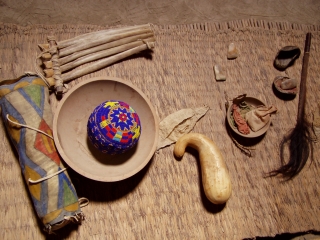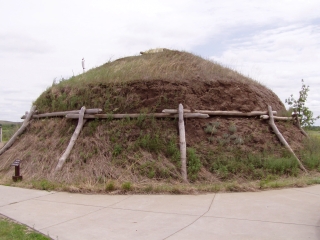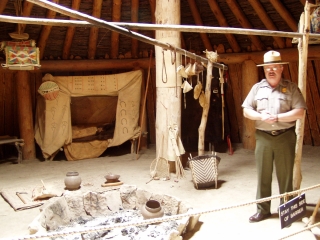Local Website
 WHAT IS IT?
WHAT IS IT?Site of a Hidatsa Village which was inhabited for over 500 years. Imprints of earthlodges cover the landscape. One earthlodge has been reconstructed and furnished as it would have been in the early 1800s. This is a stop on the Lewis and Clark Trail.
BEAUTY (6/10)
The Visitors Center and earth lodge are situated amid native prairie grass. Nature trails walk you past the village site remains and down to the Missouri River floodplain. We brought our binoculars and tried to familiarize ourselves to plants and birds we were seeing for the first time.
It took us a while to notice, but the Visitor's Center is actually shaped in the form of an eagle with its claws outstretched and facing upwards, a figure we saw again in other Hidatsa artifacts.
The earthlodge is amazing. Visitors push aside a buffalo hide door, complete with buffalo hoof doorbells and enter a different era. Embers are still burning on the hearth fire. Rangers actually use the buffalo scapula hoe and antler rake which lean against one of the four huge wooden pillars that anchor the mound. Beds, complete with canopies for married couples of the family unit, are dressed with buffalo hides and furs. Brightly colored baskets and storage containers hung from the ceiling. It felt like a home, and a very comfortable one at that.
HISTORICAL INTEREST (8/10)
Thanks to paintings and sketches by artists Karl Bodmer and George Catlin and to oral stories of the Hidatsa, we have a very good idea of how the Knife River Indian Villages may have looked 200 years ago. Agriculture and trade were the cornerstones of Hidatsa society. The location next to the Missouri River was ideal for both.
The Hidatsa were not the first occupants of this fertile land. Archeologists believe the Knife River area has been home to humans for at least 11,000 years.
Lewis and Clark spent the winter of 1804-05 at nearby Fort Mandan, which they named for the neighboring Mandan and Hidatsa tribes. Sakakawea (Sacagewea) and her husband Toussaint Charbonneau were living with the Hidatsa when Lewis and Clark arrived in the area. Charbonneau, an “unaffiliated, independent fur trader,” joined the Corps of Discovery as a translator. His wife came along and soon proved to be the more valuable addition to the team.
There is controversy over Sakakawea’s ancestry. Hidatsa maintain that she was one of their people, not kidnapped or brought over from another tribe (which is often how the story is told). The Journals of Lewis and Clark state that she was a member of a western tribe since she referred to an Indian Chief as “brother.”
Because the Knife River Valley was a trading hub, it is very possible that Sakakawea had previous contact with other Native American tribes and may have used this term as a friendly greeting, rather than to denote actual blood relations. The Visitors Center tries to present both theories, but respectfully refers to the Indian woman using the Hidatsa spelling (Sakawea) and pronunciation of her name (sah-kah-kah-WAY-ah).
 CROWDS (7/10)
CROWDS (7/10)Visitation has increased over the last couple of years as tourists embark on the Lewis and Clark Trail. Our tour of the earthlodge was with a very manageable group of six people. A ranger warned us of a large crowd in the lobby as we were preparing to exit the movie room. We appreciated the heads up, but had no trouble sharing the space with the busload that had just arrived. It was nice to see so many people at a site that is well off the beaten path.
EASE OF USE/ACCESS (3/5)
Knife River Villages NHS is on a small county road about 60 miles north of Bismarck, next to the tiny town of Stanton. We drove quite a bit to get there. Once at the site, most everything is accessible. The Visitors Center has a spacious rotunda. The earthlodge is situated just behind it. The trail to the upper village is flat, but not paved.
CONCESSIONS/BOOKSTORE (4/5)
Although not large, the bookstore had an impressive selection of books on Sakakawea, the Hidatsa and Mandan and other Native American tribes, Lewis and Clark, the Corps of Discovery, the Smallpox epidemic and the 1800s in general.
COSTS (5/5)
There is no charge to visit Knife River Villages NHS. Ranger-led tours are free.
RANGER/GUIDE TO TOURIST RATIO (5/5)
Not only was there an adequate number of Rangers to assist the steady stream of visitors, but there were also historians available to answer our many, many questions. All of the Rangers we spoke to were very knowledgeable about the Hidatsa and Mandan people, the Lewis and Clark Expedition and the flora and fauna of the Plains.
TOURS/CLASSES (8/10)
Excellent. We arrived just a few minutes before an earthlodge tour. We had just enough time to grab a brochure, get our camera ready and follow the Ranger out the door to the reconstructed lodge. The tour began immediately, with him explaining the construction of the mound and the grasses and plants which cover the outside of the walls.
The Ranger kindly gave us a minute to acclimate ourselves after we walked into the lodge, then shared as much as he knew about its origins, uses, contents and inhabitants. There was a young girl in our group who was eager to touch and hold everything and asked a lot of questions. He didn’t protest. In fact, once she was finished examining an object, he made sure that we all had a chance to see it close up. He addressed all of her questions and engaged the rest of group in the responses.
There was a small museum and exhibit focused on the Mandan, Hidatsa and Arikara nations, now known as the Three Affiliated Tribes. A video, based on the first hand account of Buffalo Bird Woman, rounds out the Visitors Center’s offerings.
 FUN (8/10)
FUN (8/10)We were overwhelmed with the volume of information we tried to digest here. We knew so little about the Plains Indians and this part of the country that all facts were new. We spent two to three hours at this site, most of it in the bookstore and at the front desk talking with Rangers trying to put two and two together and connect these points of views with more familiar timelines and historical highlights.
The rest of the time we spent walking the short trails and touring the inside the earthlodge where all of our senses were put to work. We smelled the dying fire. We touched the buffalo hide blankets and wall coverings. We held the bowls and plates made of stone, wood and bone. Our eyes adjusted to the dim lighting from the central skylight and we listened intently as the Ranger told us about every object and its purpose. By the end of the day, we were exhausted, but very glad we made the trip.
WOULD WE RECOMMEND? (8/10)
Today feels like one of the first days we are truly moving westward. The landscape is changing. The sky seems to be widening. To be learning so much in an environment so new made for a very exciting and invigorating day. This site is out of the way for everyone except for the residents of central North Dakota but well worth the drive, especially if you have the Lewis and Clark Bicentennial bug, which we seem to have caught.
TOTAL 62/80
www.usa-c2c.com
© 2004-06